Othiana Roffiel
ARTIST
Othiana Roffiel (MEXICO CITY, b. 1990)
PAINTING, SCULPTURE
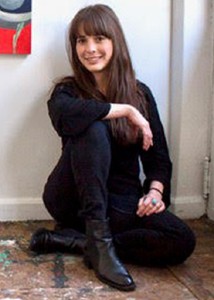
FEBRERO 2021
Navigating-the-in-between
Interview with Othiana Roffiel
BY REGINA DE CON COSSÍO
Photographs Courtesy of the Artist
If you look at the works of Othiana Roffiel from afar, you may get the wrong impression. Her artistic pieces seem intuitive and sensory. Emotional, perhaps. However, behind them there are also intellectual processes and deep investigations. Some of them may border on semiotics, that science projected by Charles Sanders Peirce in the United States at the beginning of the 20th century.
Othiana Roffiel plays with the titles of her works to add layers of meaning. Her paintings are playful and hazardous, but they are also like memory time machines. Among the less obvious aspects of her work is feminism, which she adopts naturally: away from pamphlets or manifestos. Some specialized media have identified her as one of the most striking figures of her generation. In it, formal risk is not a statement to describe her work but an inescapable slogan.
Like few artists, Othiana Roffiel combines her aesthetic interests with writing. In this way, she links processes of the language of letters with that of images. The result is remarkable: the meanings that emerge from her pieces point in different directions. Sometimes complementary; many others, contradictory.
Othiana Roffiel (Mexico City, 1990) unveiled in 2019 The Persistent Insistence of Play at Casa Equis in Mexico City, curated by Leslie Moody Castro. Her work has been part of diverse group shows in museums, galleries and alternative spaces in both Mexico and the United States. In July this year she will have a solo show with Galería Karen Huber.
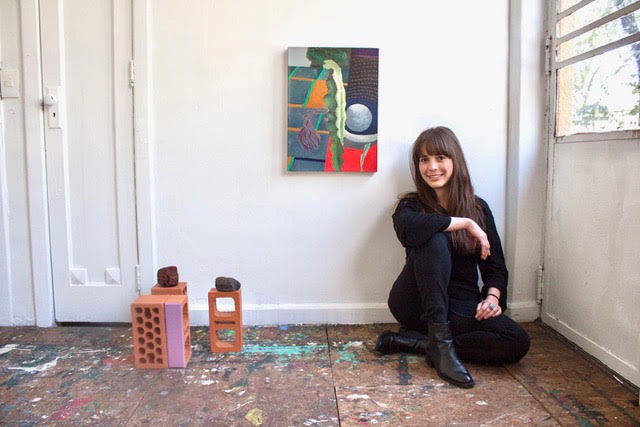
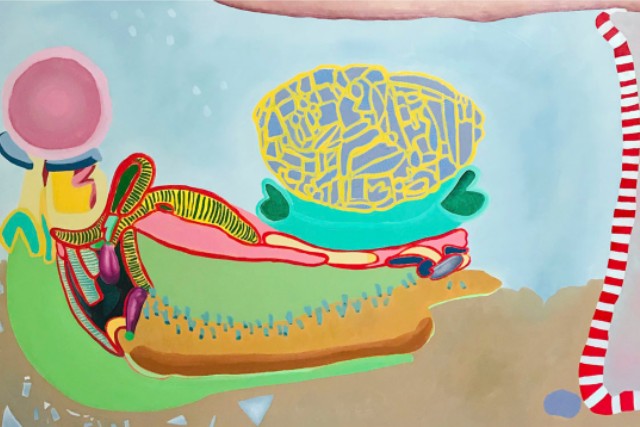
Regina De Con Cossío: Some artists work with intuitive and emotional processes. Many others do so from a reasoned and even intellectual perspective. I have the impression that in your case there is a fusion of both. You have a solid discourse around your work but you also leave room for emotions to play an important role when producing pieces of art. How does this relationship between the rational and the intuitive happen in your work?
Othiana Roffiel: It is a to and fro; and it is precisely this swaying movement which generates layers of meaning in my works. Some layers—both material and conceptual—are more intuitive and others more intellectual. Still, they are not mutually exclusive, but rather operate in a continuum; they affect and constantly reconfigure each other. Sometimes it is even hard to figure out which is at work at a given moment.
Last May, because of the current pandemic, I moved my studio to the Mexican countryside—a different context from my usual one in Mexico City. When I first arrived at Nepantla—the birthplace of Sor Juana Inés de la Cruz, 17th century writer and poet who is now considered a feminist icon—I was inevitably enthralled by the region’s flora and immediately felt the urge to paint the cacti that surrounded me. This drive was purely intuitive, it stemmed from a feeling, from a need, and that was something difficult to rationalize. Yet, once I started to actually work on these paintings a more analytical sort of thinking came into play and discursive layers started to emerge.
RDCC: In The Persistent Insistence of Play there is a vestige of childhood, is that correct? The works have great aesthetic power. But the playful rhythm seems to be connected with the games that many of us play in our childhood at home or at school for fun. This relationship between your present SELF and your past SELF can be seen as time travel. A search for memory. How do you work with these concepts (time and memory) in your artistic production?
OR: One of the things that most fascinates me in painting is change and change is inevitably tied to time. Earlier I was speaking about how meaning is constructed, but maybe a better word is “accumulated”—meaning in a painting is accumulated through time; through the time invested in the manipulation of the material, in the struggle to find forms which will remain, and in navigating (though mostly wrestling) from layer to layer. You think a work is finished, but then turn it around (literally and metaphorically) and realize it is asking for something else.
This is what happened with the pieces in The Persistent Insistence of Play, where the transformation didn’t only take place in the many layers that constitute each canvas, but these mistakenly “finished” paintings ended up absorbing fragments (the cutouts) from other works, which later lead to the creation of 3D elements that became parts of the pieces themselves. The temporality of these paintings multiplied. After being made and even exhibited, artworks continue to change; how they are perceived is informed by the spaces they occupy and the reading of them evolves over time.
Now, about memory… Our memory is a repertoire of… well, everything! The spaces, hues, surfaces, shapes, compositions and relationships I come across daily inevitably linger in my thoughts and residues of these appear in my paintings. Sometimes I consciously take from this pool of information, but others I am not aware of it until it happens. I might mix certain colors intuitively and once the painting is finished realize that they are the colors of the building in front of my studio!
More so, I approach painting via abstraction and memory plays a crucial role in the processes that come with this specific breed of painterly language. When you are thinking and working through abstraction you are constantly searching for things (forms, colors, situations) without really knowing what they look like until you encounter them. An artist, I believe Amy Sillman, compares this process to rummaging for something in a dark room, except you don’t know what you are hunting for. You might not be able to see, but your other senses are running. How you take in what you touch, hear, smell (and maybe even taste) in that obscure space is being informed by recollection. You sort through a pile of diverse objects and feel something, let’s say, something soft, yet even though it’s not recognizable, you inevitably associate it with elements you’ve interacted with in the past. But for some reason you decide that even though it feels nice and fluffy, that isn’t what you are seeking for and you continue to move across the dark room. Then, you all of a sudden slip with an object, fall on your buttocks and after collecting yourself, grab the item responsible for the debacle and realize it’s exactly what you had been trying to find for the past five hours (or five months). How do you know? You just do. Perhaps it’s the intuition we were talking about earlier? You mentioned childhood, isn’t this exactly how kids move through the world?
RDCC: The dedication you have for writing arts texts in different media or for various exhibitions is remarkable. What is the relationship that you find in your work process between art and writing?
I have always felt a strong affinity with the written word, yet writing has played a different role in my practice at distinct moments—though I guess it has always been a way of making sense.
What drove me to art writing back in 2014 was a desire to understand my professional context (the local Mexico City contemporary art scene, as well as the international), but also a keen sense of curiosity for the diverse artistic practices that surrounded me that were apparently “different” from my own—painting. I felt that in order to comprehend these things I needed to write about them. I ended up composing reviews, articles and interviews for contemporary art platforms such as ARTPULSE (USA) and Artishock (Chile) on artists like Jill Magid, Fritzia Irízar, Rafael Lozano-Hemmer, Mario Garcia Torres, Allora & Calzadilla, Abraham Cruzvillegas, among others. Yet It wasn’t until 2018 that I finally dared to write about painting—I conceived the curatorial text for an edgy Ana Segovia one-work show, which led to further writings on the work of other painter friends.
With that said, today writing serves me other purposes and manifests itself differently than it did in the past. Though I’ve always known that these two aspects of my practice (painting and writing) complement each other, I had the sensation that they occupied separate drawers. Before I wrote to understand the enormity of the contemporary art world, now I write to probe on my own artistic processes and undertakings in order to grasp how these relate to my surroundings—yes, to the art world, but also to my mundane quotidian environment. I like to think there is more congruence between my writing and my painting now. You asked me about intuition and about the rational, writing plays a crucial role in this to and fro, it helps me organize my thoughts about what is going on in the work. For me meaning is made in the conjunction of what takes place in the studio and what on a blank page. What I write about these days strongly corresponds with what is happening with my own processes. For example, ESPAC (a Mexico City based non-profit organization, born out of a private collection, which for the past five years has supported Mexico’s artistic community) recently invited me to draught a text for a book that they will publish later this year: ABCDESPAC. My collaboration aligns with my own work not only because of the subject matter—painting—, but also because of the form the contribution takes. In it I play with different genres: the text draws from the epistolary ( it’s structured as a letter), it slightly flirts with autofiction and it also has academic touches. I feel this mirrors what happens in my paintings when I come and go between languages (abstraction and figuration) or between formats (2D and 3D).
RDCC: In this same sense, I find the way you title some of your pieces really original. In your case the titles of the works are not accidental. Is there a particular process when you name them?
OR: In the case of my more abstract works, the titles are a way of opening the paintings to the lifeworld, a way of pointing to “something else.” They are random phrases like “Hanging my Shit Out to Dry: A Start” or “Over Easy,” for example, that mostly come from whatever it is I am reading at the time. I like to be playful. I arbitrarily pair one of these phrases—I have a list—with a painting to see if they work together. It is a very intuitive process, similar to what happens with the cutouts I mentioned earlier. Yet, in my most recent series Through the Cactus, the titles function somewhat differently as they reference the thing itself—the titles of the pieces include the scientific or common name of the type of cactus portrayed.
RDCC: What are the artists that you find as references or inspiration? What processes or elements do you have in common with them?
OR: In her book The Love of Painting: Genealogy of a Success Medium (2018), Isabelle Graw (cofounder of the acclaimed journal Texte zur Kunst) uses the phrase: “no painting without conversation.” I previously spoke about the different ways in which my work comes about, well, another is most definitely through conversations––of course with artists, but also with other figures in the art word, which I might or might not know personally and may be living or dead. With each, I have a completely different sort of exchange and they enrich my practice in distinct ways.
Amy Sillman, which I mentioned before, taught me how to speak about painting in a manner that is simultaneously critical and playful. It’s thanks to her that I can now put into words processes and ideas––specifically about abstraction. Elizabeth Murray showed me that it’s ok to have weird, whacky, lumpy shapes and that for some of us, painting is about making conflicting things coexist. Last year, when I moved to the countryside because of the pandemic, Marsden Hartley and Georgia O’Keefe motivated me to engage with the landscape; they helped me discover how the forms and colors I encounter relate to my own pictorial language and how place inevitably permeates the picture frame. Rachel Harrison revealed how painterly signs operate beyond the canvas. Philip Guston that “bad painting” can actually be the best kind of painting; he also pushed me to embrace my work’s aptness to change. Laura Owens reaffirmed this by showing me that it’s all right to have a multifarious and disparate body of work that cruises between abstraction and figuration. She also incited me to truly grasp that painting always functions in relation to space. Sarah Lucas allured me with her appealingly discomfiting anthropomorphic figures and shed light on the possibilities of our everyday objects. Maria Lassnig’s awkward characters reminded me that the body is always present––it’s inescapable. Charline von Heyl allowed me to see how different sorts of painterly gestures can both couple and push against each other in a picture plane. And of course, all of the artists I just named taught me something different about one of the most fascinating aspects of painting: color.
Yet, I am incredibly grateful to also learn from my talented peers: those who pointed me to the artists I just mentioned; who I send pictures of paintings in embarrassing stages; who I constantly bounce ideas with; who see things in my work that I hadn’t before; who I call in a fit when I’ve ruined a painting. They, just like the artists I touched upon, teach me so much through their own work.
RDCC: In modern times we often hear the relationship between the visual arts and other arts (cinema, theater, etc.) or with disciplines such as science. From your point of view, how can contemporary art be defined?
OR:Art is a becoming. It’s a language that through diverse material and discursive processes of investigation establishes a situation––whether it is via the creation of an object or an experience––in which the spectator is confronted with their body, thoughts and social context. All sorts of disciplines permeate these investigations. Some artists work in the intersection of diverse fields in more overt ways, while for others, like me, this happens more organically.
I mentioned how I turn to literature when it comes to some of my titles. Also, for the past months I have been studying how the forms and colors (natural and manmade) in my surroundings relate to my pictorial vocabulary. Yet, the information I collect from my lifeworld doesn’t only come into the work in terms of the figures in the paintings, but has also permeated it in other ways: found objects such as rocks and bricks have infiltrated the space of painting, opening exciting possibilities in terms of how these elements coexist with the painted canvases in the exhibition space. When you establish such a close relationship to your environment you inevitably engage with the disciplines which study the elements you are interested in––botany (the cacti I portray), geology (the rocks I collect) or architecture (the bricks I use for my assemblages, but I have also recently been studying the hues of the local facades). Again, another to and fro takes place, this time between the studio and exhibition space, the natural environment, and our domestic habitations, which leads me to make my way through diverse disciplines. Art sets the context for us to break the hierarchies between practices, giving rise to new ways of knowing and approaching our world, and thus revealing links between our shared spaces.
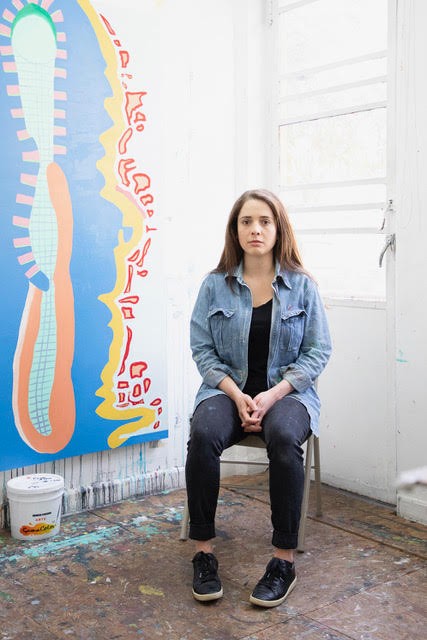
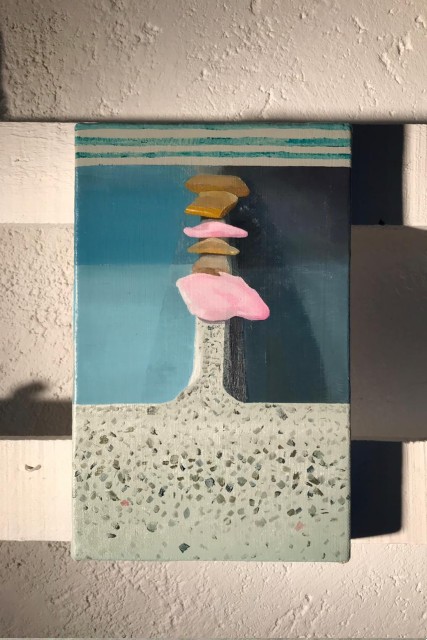
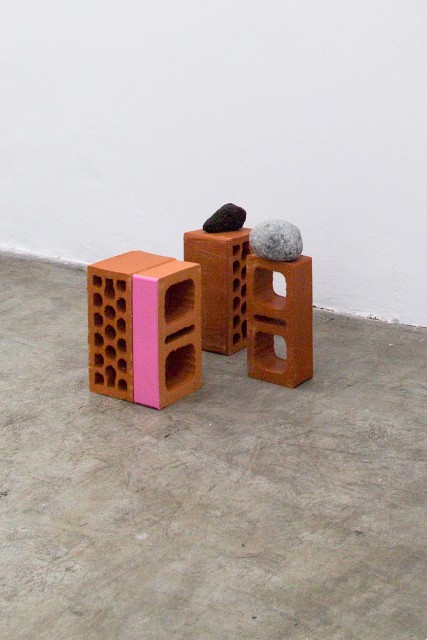
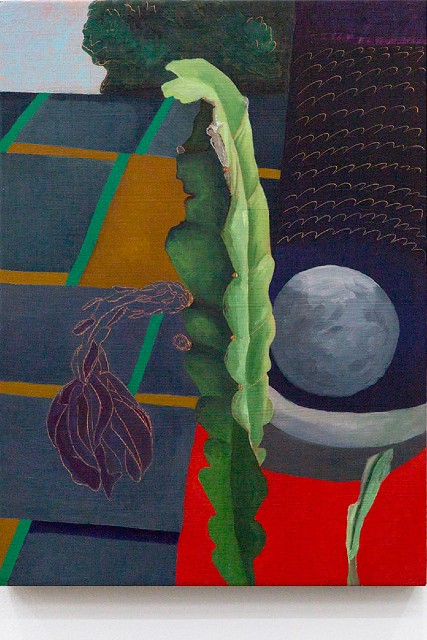
Navegando en el medio
Entrevista con Othiana Roffiel
POR REGINA DE CON COSSÍO
Fotografías cortesía de la artista
Si miras las obras de Othiana Roffiel desde lejos, puedes tener una impresión equivocada. Sus piezas artísticas parecen intuitivas y sensoriales. Emocionales, tal vez. Sin embargo, detrás de ellas hay procesos intelectuales e investigaciones profundas. Algunas de ellas pueden rayar en la semiótica, esa ciencia proyectada por Charles Sanders Peirce en Estados Unidos a principios del siglo XX.
Othiana Roffiel juega con los títulos de sus obras para añadir capas de significado. Sus pinturas son divertidas y peligrosas, pero también son como máquinas del tiempo de la memoria. Entre los aspectos menos evidentes de su obra está el feminismo, que adopta con naturalidad: alejada de panfletos o manifiestos. Algunos medios especializados la han identificado como una de las figuras más llamativas de su generación. En este sentido, el riesgo formal no es un enunciado para describir su obra sino una consigna ineludible.
Como pocos artistas, Othiana Roffiel combina sus intereses estéticos con la escritura. De esta manera vincula procesos del lenguaje de cartas con el de las imágenes. El resultado es notable: los significados que emergen de sus piezas apuntan en distintas direcciones. A veces complementario; y en muchos otros, contradictorio.
Othiana Roffiel (Ciudad de México, 1990) presentó en 2019 La Persistente Insistencia del Juego en Casa Equis de la Ciudad de México, curada por Leslie Moody Castro. Su obra ha sido parte de diversas muestras colectivas en museos, galerías y espacios alternativos tanto en México como en Estados Unidos. En julio de este año tendrá una exposición individual con la Galería Karen Huber.
Regina De Con Cossío: Algunos artistas trabajan con procesos intuitivos y emocionales. Muchos otros lo hacen desde una perspectiva razonada e incluso intelectual. Tengo la impresión de que en tu caso hay una fusión de ambos. Tienes un discurso sólido en torno a tu trabajo pero también dejas espacio para que las emociones jueguen un papel importante a la hora de producir obras de arte. ¿Cómo se da en tu obra esta relación entre lo racional y lo intuitivo?
Othiana Roffiel: Es un ir y venir; y es precisamente ese vaivén el que genera capas de significado en mis obras. Algunas capas -tanto materiales como conceptuales- son más intuitivas y otras más intelectuales. Aún así, no son mutuamente excluyentes, sino que operan en un continuo; se afectan y se reconfiguran constantemente. Incluso a veces es difícil saber cuál es el está funcionando en un momento dado.
En mayo pasado, debido a la pandemia actual, mudé mi estudio al campo, un contexto diferente al habitual en la Ciudad de México. Cuando llegué por primera vez a Nepantla, el lugar de nacimiento de Sor Juana Inés de la Cruz, escritora y poeta del siglo XVII que ahora se considera un ícono feminista, inevitablemente me cautivó la flora de la región e inmediatamente sentí la necesidad de pintar los cactus que me rodeaban. Este impulso era puramente intuitivo, brotaba de un sentimiento, de una necesidad, y eso era algo difícil de racionalizar. Sin embargo, una vez que comencé a trabajar en estas pinturas, entró en juego un tipo de pensamiento más analítico y comenzaron a surgir capas discursivas.
RDCC: En La Persistente Insistencia del Juego hay un vestigio de la infancia, ¿cierto? Las obras tienen un gran poder estético. Pero el ritmo lúdico parece estar conectado con los juegos que muchos de nosotros jugamos para divertirnos, ya fuera en nuestra infancia en casa o en la escuela. Esta relación entre tu YO del presente y tu YO del pasado puede verse como un viaje en el tiempo. Una búsqueda de la memoria. ¿Cómo trabajan estos conceptos (tiempo y memoria) en tu producción artística?
OR: Una de las cosas que más me fascinan en la pintura es el cambio y el cambio está inevitablemente ligado al tiempo. Anteriormente hablé sobre cómo se construye el significado, pero tal vez una palabra mejor sea “acumula” -el significado en una pintura se acumula a través del tiempo; a través del tiempo invertido en la manipulación del material, en la lucha por encontrar formas que permanecerán y en navegar (aunque sobre todo luchando) de capa en capa. Crees que una obra está terminada, pero luego le das la vuelta (literal y metafóricamente) y te das cuenta de que está pidiendo algo más.
Así sucedió con las piezas de La persistente Insistencia del Juego, donde la transformación no solo se dio en las muchas capas que constituyen cada lienzo, sino que estas pinturas erróneamente “terminadas” terminaron absorbiendo fragmentos (los recortes) de otras obras que luego dieron lugar a la creación de elementos 3D que se convirtieron en partes de las propias piezas. La temporalidad de estas pinturas se multiplicó. Después de ser hechas e incluso exhibidas, las obras de arte continúan cambiando; cómo se perciben está influenciado por los espacios que ocupan y la lectura de ellos evoluciona con el tiempo.
Ahora, sobre la memoria… Nuestra memoria es un repertorio de… ¡bueno, de todo! Los espacios, matices, superficies, formas, composiciones y relaciones con los que me encuentro a diario, inevitablemente, permanecen en mis pensamientos y los residuos de estos aparecen en mis pinturas. A veces aprovecho conscientemente este conjunto de información, pero otras no me doy cuenta hasta que sucede. ¡Puedo mezclar ciertos colores intuitivamente y una vez que la pintura está terminada me doy cuenta de que son los colores del edificio frente a mi estudio!
Más aún, me acerco a la pintura a través de la abstracción y la memoria juega un papel crucial en los procesos que vienen con esta técnica específica de lenguaje pictórico. Cuando piensas y trabajas a través de la abstracción, estás constantemente buscando cosas (formas, colores, situaciones) sin saber realmente cómo son hasta que las encuentras. Una artista, creo que Amy Sillman, compara este proceso con buscar algo en una habitación oscura, excepto que no sabes lo que estás buscando. Es posible que no pueda ver, pero sus otros sentidos funcionan. La forma en que asimilas lo que tocas, escuchas, hueles (y tal vez incluso saboreas) en ese espacio oscuro está siendo influenciado por recuerdos. Cuando ordenas un conjunto de diversos objetos y sientes algo, digamos, algo suave, aunque no sea reconocible visualmente, inevitablemente lo asocias con elementos con los que has interactuado en el pasado. Pero por alguna razón decides que, aunque se siente agradable y esponjoso, eso no es lo que estás buscando y continúas moviéndote por el cuarto oscuro. Entonces, de repente te tropiezas con un objeto, caes sobre tus nalgas y después de incorporarte, tomas el objeto responsable de la caída y te das cuenta de que es exactamente lo que habías estado tratando de encontrar durante las últimas cinco horas (o cinco meses). ¿Cómo lo sabes? solo lo haces ¿Quizás es la intuición de la que hablábamos antes? Mencionaste la infancia, ¿no es así exactamente como los niños se mueven por el mundo?
RDCC: Es destacable la dedicación que tienes para escribir textos de arte en diferentes medios o para diversas exposiciones. ¿Cuál es la relación que encuentras en tu proceso de trabajo entre el arte y la escritura?
OR: Siempre he sentido una gran afinidad con la palabra escrita, pero la escritura ha jugado un papel diferente en mi práctica en distintos momentos, aunque supongo que siempre ha sido una forma de dar sentido.
Lo que me llevó a escribir sobre arte desde el 2014 fue el deseo de comprender mi contexto profesional (la escena artística contemporánea local de la Ciudad de México, así como la internacional), pero también un agudo sentido de curiosidad por las diversas prácticas artísticas que me rodeaban y que eran aparentemente “diferentes” a mi propia pintura. Sentí que para comprender estas cosas necesitaba escribir sobre ellas. Terminé escribiendo reseñas, artículos y entrevistas para plataformas de arte contemporáneo como ARTPULSE (USA) y Artishock (Chile) sobre artistas como Jill Magid, Fritzia Irízar, Rafael Lozano-Hemmer, Mario Garcia Torres, Allora & Calzadilla, Abraham Cruzvillegas, entre otros. Sin embargo, no fue hasta 2018 que finalmente me atreví a escribir sobre pintura: concebí el texto curatorial para una vanguardista exposición de una sola obra de Ana Segovia, lo que me llevó a escribir más sobre el trabajo de otros amigos pintores.
Dicho esto, hoy escribir me sirve para otros propósitos y se manifiesta de manera diferente a como lo hacía en el pasado. Aunque siempre supe que estos dos aspectos de mi práctica (pintura y escritura) se complementan, tuve la sensación de que ocupaban cajones separados. Antes escribía para comprender la enormidad del mundo del arte contemporáneo, ahora escribo para indagar en mis propios procesos y emprendimientos artísticos para comprender cómo se relacionan, si con mi entorno y con el mundo del arte, pero también con mi entorno mundano y cotidiano. Me gusta pensar que ahora hay más congruencia entre mi escritura y mi pintura. Me preguntaste sobre la intuición y sobre lo racional, la escritura juega un papel crucial en este ir y venir, me ayuda a organizar mis pensamientos sobre lo que está pasando en el trabajo. Para mí el significado se hace en la conjunción de lo que sucede en el estudio y lo que está en una página en blanco. Lo que escribo estos días se corresponde fuertemente con lo que está pasando con mis propios procesos. Por ejemplo, ESPAC (una organización sin fines de lucro con sede en la Ciudad de México, nacida de una colección privada, que durante los últimos cinco años ha apoyado a la comunidad artística de México) me invitó recientemente a redactar un texto para un libro que publicarán a finales de este año: ABCDESPAC. Mi colaboración se alinea con mi propio trabajo no solo por el tema -la pintura- sino también por la forma que toma la contribución. En él juego con diferentes géneros: la forma del texto epistolar (está estructurado como una carta), coquetea ligeramente con la autoficción y también tiene toques académicos. Siento que esto refleja lo que sucede en mis pinturas cuando voy y vengo entre lenguajes (abstracción y figuración) o entre formatos (2D y 3D).
RDCC: En este mismo sentido, encuentro muy original la forma en que titulas algunas de tus piezas. En su caso los títulos de las obras no son casuales. ¿Hay algún proceso en particular cuando los nombras?
OR: En el caso de mis obras más abstractas, los títulos son una forma de abrir las pinturas al mundo de la vida, una forma de señalar “algo más”. Son frases aleatorias como “Hanging my Shit Out to Dry: A Start” o “Over Easy”, por ejemplo, que en su mayoría provienen de lo que sea que esté leyendo en ese momento. Me gusta ser juguetona. Combino arbitrariamente alguna de estas frases (tengo una lista) con una pintura para ver si funcionan juntas. Es un proceso muy intuitivo, similar a lo que sucede con los recortes que mencioné anteriormente. Sin embargo, en mi serie más reciente Through the Cactus, los títulos funcionan de manera un tanto diferente ya que hacen referencia a la cosa en sí: los títulos de las piezas incluyen el nombre científico o común del tipo de cactus pintado.
RDCC: ¿Cuáles son los artistas que encuentras como referentes o inspiración? ¿Qué procesos o elementos tienes en común con ellos?
OR: : En su libro The Love of Painting: Genealogy of a Success Medium (2018), Isabelle Graw (cofundadora de la aclamada revista Texte zur Kunst) usa la frase: “no hay pintura sin conversación”. Anteriormente hablé sobre las diferentes formas en que surge mi trabajo, bueno, definitivamente otra forma es a través de conversaciones, por supuesto con artistas, pero también con otras personalidades en la palabra arte, que podría o no conocer personalmente y que pueden estar vivas o muertas. Con cada una, tengo un tipo de intercambio completamente diferente y enriquecen mi práctica de distintas maneras.
Amy Sillman, a la que mencioné antes, me enseñó a hablar sobre la pintura de una manera crítica y lúdica a la vez. Es gracias a ella que ahora puedo poner en palabras procesos e ideas, -específicamente sobre abstracción. Elizabeth Murray me mostró que está bien tener capas extrañas, extravagantes y grumosas y que, para algunos de nosotros, pintar consiste en hacer que coexistan cosas en conflicto. El año pasado, cuando me mudé al campo por la pandemia, Marsden Hartley y Georgia O’Keefe me motivaron a trabajar con el paisaje; me ayudaron a descubrir cómo las formas y los colores que encuentro se relacionan con mi propio lenguaje pictórico y cómo el lugar impregna inevitablemente el marco de la imagen. Rachel Harrison reveló cómo los signos pictóricos operan más allá del lienzo. Philip Guston que la “mala pintura” en realidad puede ser la mejor pintura; él también me empujó a abrazar la relevancia de mi trabajo. Laura Owens reafirmó esto mostrándome que está bien tener un cuerpo de trabajo multifacético y variado que navega entre la abstracción y la figuración. También me impulsó a comprender que la pintura siempre funciona en relación con el espacio. Sarah Lucas me sedujo con sus figuras antropomórficas atractivamente incómodas e iluminó sobre las posibilidades de nuestros objetos cotidianos. Los personajes incómodos de Maria Lassnig me recordaron que el cuerpo siempre está presente –es ineludible. Charline von Heyl me permitió ver cómo diferentes tipos de gestos pictóricos pueden acoplarse y empujarse unos contra otros en un plano pictórico. Y por supuesto, todos los artistas que acabo de nombrar me enseñaron algo diferente sobre uno de los aspectos más fascinantes de la pintura: el color.
Aún más, estoy increíblemente agradecida de aprender también de mis compañeros talentosos: aquellos que me mostraron a los artistas que acabo de mencionar; a quienes envío fotos de cuadros en etapas vergonzosas; con quienes constantemente intercambio ideas; que ven cosas en mi trabajo que yo no había visto antes; a quienes llamó en un ataque cuando arruino un cuadro. Ellos, al igual que los artistas que mencioné, me enseñan mucho a través de su propio trabajo.
RDCC: En los tiempos modernos escuchamos a menudo la relación entre las artes visuales y otras artes (cine, teatro, etc.) o con disciplinas como la ciencia. Desde tu punto de vista, ¿cómo se puede definir el arte contemporáneo?
OR: El arte es un devenir. Es un lenguaje que a través de diversos procesos materiales y discursivos de investigación establece una situación –ya sea a través de la creación de un objeto o de una experiencia– en la que el espectador se confronta con su propio cuerpo, pensamiento y contexto social. Todo tipo de disciplinas impregnan estas investigaciones. Algunos artistas trabajan en la intersección de diversos campos de manera más abierta, mientras que para otros, como yo, esto sucede de manera más orgánica.
Mencioné cómo recurro a la literatura cuando se trata de algunos de mis títulos. Además, durante los últimos meses he estado estudiando cómo las formas y los colores (naturales y hechos por el hombre) en mi entorno se relacionan con mi vocabulario pictórico. Sin embargo, la información que recopilo de mi de vida no solo entra en la obra en términos de las figuras de las pinturas, sino que también la ha permeado de otras maneras: los objetos encontrados, como rocas y ladrillos, se han infiltrado en el espacio de la pintura, abriendo apasionantes posibilidades en cuanto a cómo estos elementos conviven con los lienzos pintados en el espacio expositivo. Cuando estableces una relación tan estrecha con tu entorno, inevitablemente te comprometes con las disciplinas que estudian los elementos que te interesan -la botánica (los cactus que pinto), la geología (las rocas que recolecto) o la arquitectura (los ladrillos que uso para mis ensamblajes, pero también he estado estudiando recientemente las tonalidades de las fachadas locales). Nuevamente se produce otro vaivén, esta vez entre el estudio y el espacio expositivo, el entorno natural y nuestras habitaciones domésticas, lo que me lleva a transitar por diversas disciplinas. El arte establece el contexto para que rompamos las jerarquías entre prácticas, dando lugar a nuevas formas de conocer y acercarnos a nuestro mundo, y así revelar vínculos entre nuestros espacios compartidos.


